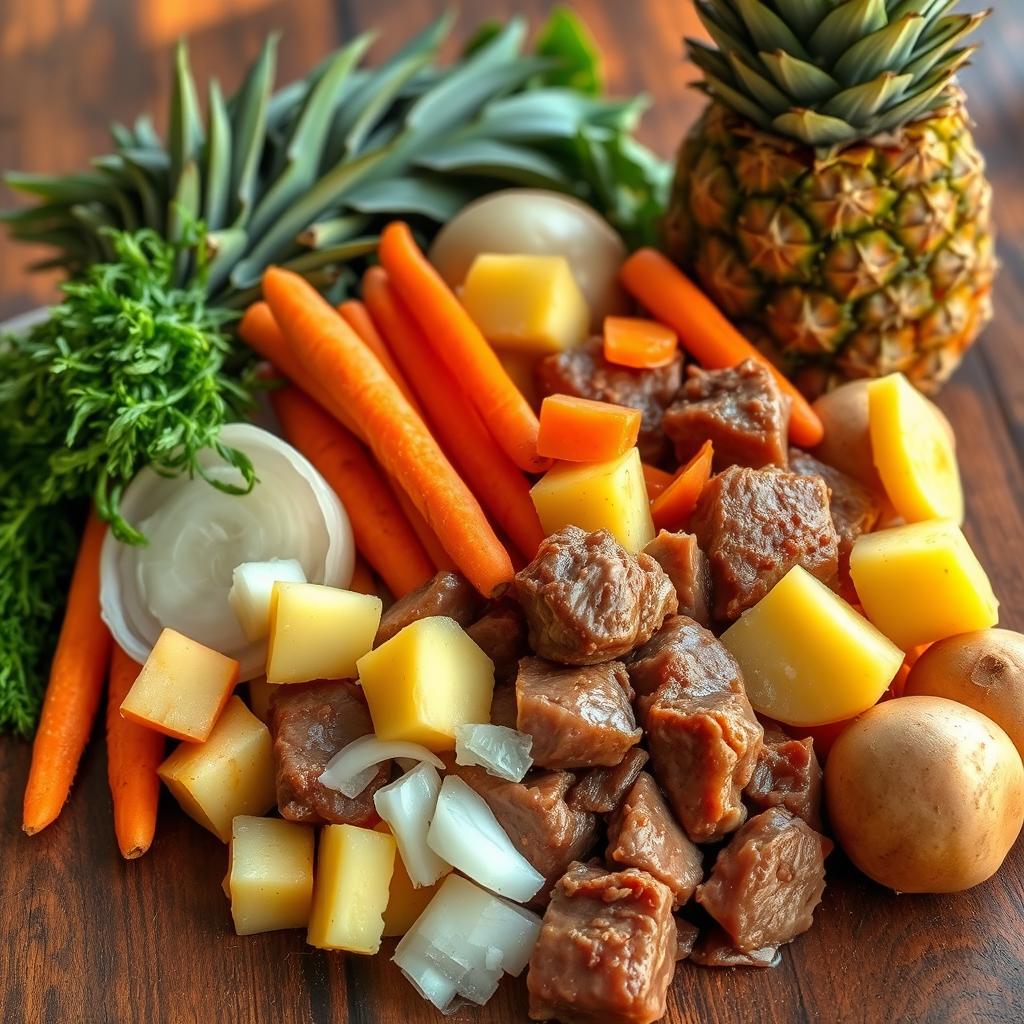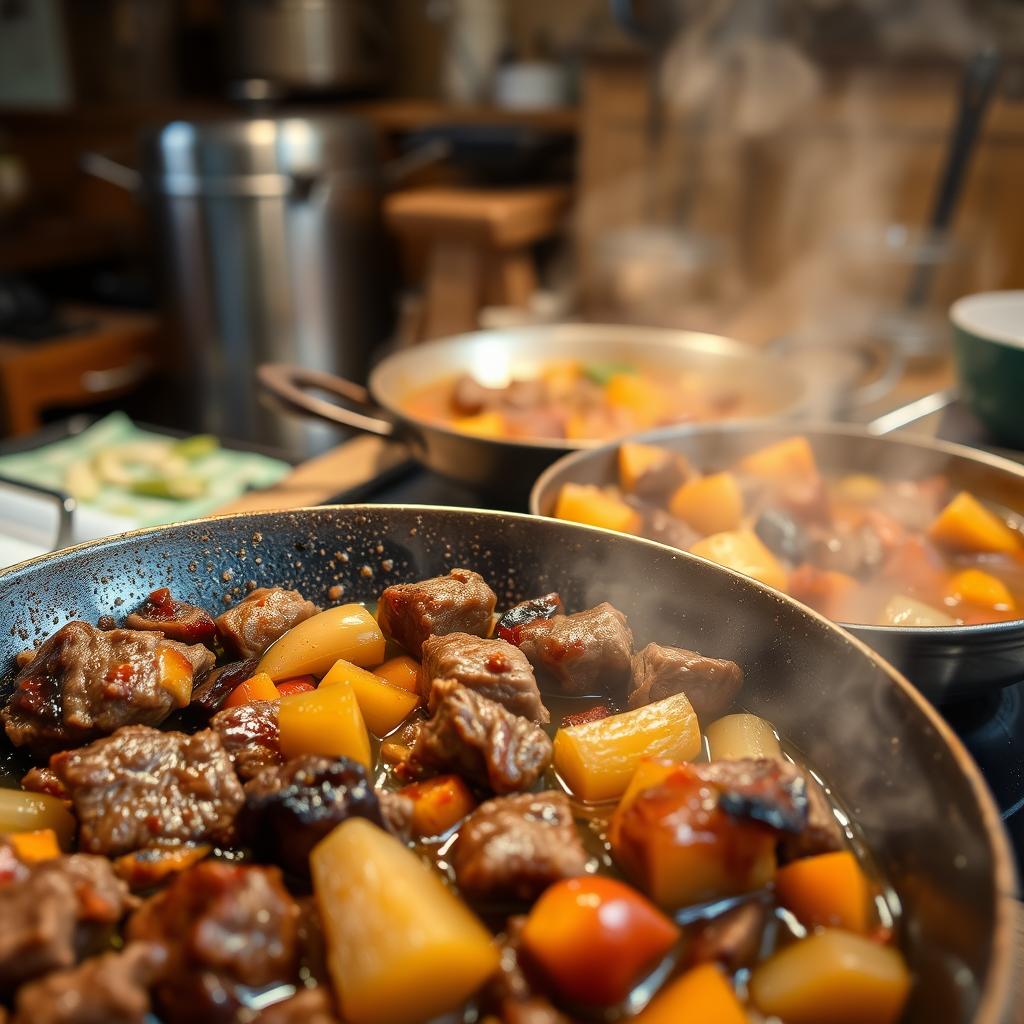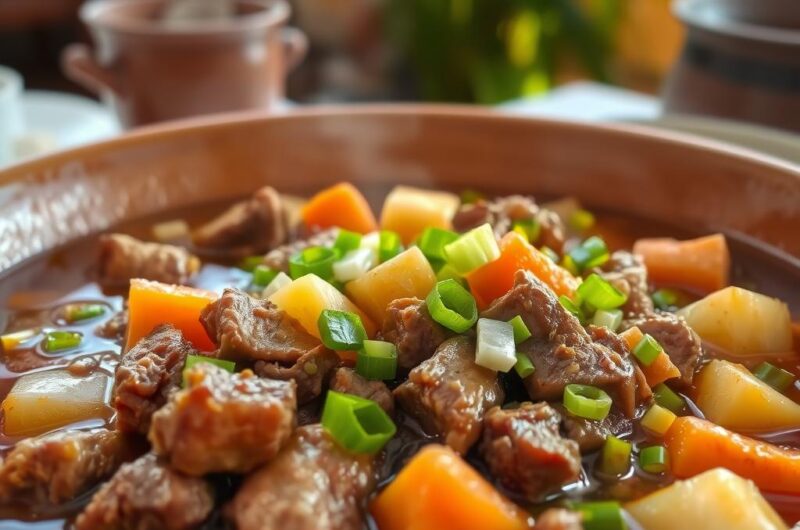The Best Fluffy Pancakes recipe you will fall in love with. Full of tips and tricks to help you make the best pancakes.
Imagine a pot filled with Hawaii’s flavors—soy sauce, ginger, and slow-cooked beef. The hawaiian beef stew recipe is more than food; it’s a story of family and heritage. It brings people together, just like Grandpa Clarence’s famous version did.
His secret was patience. It allowed the ingredients to blend into a dish that warms the soul.
Key Takeaways
- This recipe blends Japanese, Portuguese, and Filipino influences into one comforting bowl.
- Grandpa Clarence’s method prioritizes slow cooking for maximum tenderness and flavor.
- Steamed rice and local veggies like taro or sweet potatoes elevate the traditional hawaiian beef stew recipe.
- Each family adds personal touches, making it a dish as unique as the islands themselves.
- It’s a celebration of aloha—shared with loved ones during holidays or simple weeknights.
This stew is at the heart of Hawaii. It connects cultures and generations. Ready to taste the islands?
A Journey into Hawaiian Comfort Food
Traditional beef recipe dishes in Hawaii are more than meals—they’re stories. Imagine simmering stews passed down through generations. Every spoonful carries memories of family gatherings and island life.
Hawaiian comfort food blends Polynesian, Asian, and American flavors. The beef recipe for this stew isn’t just about ingredients. It’s a connection to the land and sea. Think tender beef slow-cooked with local taro, sweet potatoes, and maybe a touch of coconut milk for richness.

“The best meals are those that remind us where we come from,” says a Honolulu chef. He emphasizes how islanders preserve traditions through cooking.
Key elements of this comfort food include:
- Slow-cooked beef for melt-in-your-mouth texture
- Local produce like Maui onions and Kona salt
- Warm spices that echo Hawaiian hospitality
Every pot of stew tells a story—of plantation workers sharing meals, or families celebrating holidays. It’s a dish that adapts yet stays true. This is why the beef recipe remains a symbol of aloha in every bite.
Essential Ingredients for an Authentic Hawaiian Stew
Choosing the right Fresh Beef Selections is key to a great dish. Beef chuck is best because it’s tender when slow-cooked. Stay away from lean cuts like sirloin, as they can get dry. For the best taste, pick local butchers or markets with pasture-raised beef.

- Beef: Fresh Beef Selections like chuck roast provide rich flavor and texture.
- Vegetables: Carrots, celery, and potatoes add natural sweetness. Dice potatoes evenly to avoid mushiness.
- Spices: Shoyu (soy sauce), garlic, and ginger form the savory base. Add a splash of rice vinegar for a subtle tang.
- Extras: Fresh pineapple chunks and Maui onions highlight island flavors without overpowering the beef.
Quality is important: Use ripe tomatoes or top-notch tomato sauce for depth. Fresh herbs like cilantro or basil add brightness when stirred in at the end. Always check expiration dates on pantry staples like broth and spices to ensure peak flavor.
Techniques for a Tender and Flavorful Beef
Mastering Searing vs. Simmering is key to perfecting Hawaiian beef stew. The right timing and temperature turn tough cuts into fork-tender bites. Start with searing: high heat browns the meat’s surface, locking in juices and building flavor. Use a cast-iron skillet for even browning.

- Searing: Cook over medium-high heat until crust forms—3-4 minutes per side.
- Simmering: Reduce heat to low, cover, and let cook 2-3 hours. Slow and steady breaks down collagen into silky texture.
Slow cookers excel at simmering hands-free. Stovetop lets you adjust heat instantly. Both methods work, but timing is crucial. Over-searing dries meat; under-simmering leaves it chewy. Balance these steps for depth and tenderness.
Pro tip: Always pat beef dry before searing. Moisture steams instead of browns. Once simmering, avoid lifting the lid—fluctuating temps disrupt the slow cooking process. This patience pays off in rich, velvety results.
Unlocking the Secrets of Traditional Hawaiian Cuisine
Traditional Hawaiian cooking focuses on the one-pot meal. This method is all about being resourceful and valuing each ingredient. For years, families have used it to make dishes that are both simple and full of flavor.
The one-pot meal is more than just a way to cook. It’s a way to celebrate community and the joy of waiting for food to cook.

“The best meals come from what the land gives us, cooked with care.” – Kānaka Maoli culinary traditions
Using fresh, local ingredients like taro leaves and ulu (breadfruit) is key. Slow cooking brings out the best in these ingredients. Here’s how to keep this tradition alive:
- Layer ingredients in a Dutch oven or imu (underground oven) to trap steam and flavors.
- Simmer on low heat to meld flavors without overcomplicating the process.
- Season with salt and fresh herbs first—let the ingredients speak for themselves.
Today, we use cast-iron pots to keep this tradition alive. But the idea remains the same: simplicity is the key. By mastering the one-pot meal, you’re not just cooking. You’re connecting to a story of resilience and joy passed down through generations. Every bite is a taste of aloha and the art of turning simple steps into unforgettable flavors.
Mastering the Hawaiian Beef Stew Recipe
Learn to make a savory stew that’s perfect with step-by-step preparation for your kitchen. This guide will show you how to mix tender meat, bold flavors, and island spices for a great dish.
- Brown beef chunks in a hot pot until golden, ensuring caramelization for depth. Remove and set aside.
- Sauté onions and garlic until translucent, then add tomato paste and spices like ginger and turmeric for warmth.
- Return beef to the pot. Pour in beef broth and coconut milk for creaminess. Simmer uncovered for 1 hour on stovetop or 4 hours slow cooker low.
- Stir in diced taro, potatoes, and carrots 30 minutes before done. Adjust salt and add a splash of soy sauce for umami.
- Finish with fresh cilantro and a squeeze of lime for brightness. Serve warm with steamed rice.
| Method | Steps | Cook Time |
|---|---|---|
| Stovetop | Brown beef first, simmer 1.5–2 hours | 2 hours total |
| Slow Cooker | Add ingredients raw; cook on low 6–8 hours | 8 hours |
| Instant Pot | Pressure cook 35 mins + 10 mins natural release | 1.5 hours |
Try different step-by-step preparation methods to fit your schedule. Whether using a pot or Instant Pot, focus on building flavors. Start strong, add depth, and finish with freshness. Each method brings out the rich texture and island flavor you love.
Incorporating Island Spices: A Flavor Profile
Beef stew with pineapple gets its unique taste from tropical spices. These spices mix bold and subtle flavors. The sweetness of pineapple pairs well with savory spices, adding depth to each bite.
Spices like turmeric, ginger, and garlic are the foundation. They add warmth without taking over the dish. Here are some spices to consider:
- Turmeric: earthy and slightly peppery
- Ground ginger: zesty and bright
- Paprika: smoky undertones
| Spice | Flavor Profile | Recommended Amount |
|---|---|---|
| Curry powder | Warm, complex | 1 tsp per 4 servings |
| Black pepper | Pungent, aromatic | ½ tsp |
| Sea salt | Enhances other flavors | To taste |
Begin with small amounts and adjust to taste. Pineapple’s acidity balances the richness of the meat. Adding lemongrass or chili flakes can enhance the tropical flavor without overpowering the dish.
Try different spice combinations to find your perfect balance. Let the stew simmer to fully blend the flavors. This way, you’ll enjoy a dish that brings the island’s vibrant taste to your plate.
Slow Cooker vs Stovetop: Finding Your Best Method
Choosing between a slow cooker and stovetop for Hawaiian beef stew depends on your priorities. Slow Cooker Advantages shine with their hands-off approach, perfect for busy schedules. Place ingredients in the pot, set the heat, and walk away. The gentle, extended cooking time breaks down meat fibers, ensuring tender results with minimal effort.
- Slow cooker: 6-8 hours on low; ideal for overnight prep.
- Stovetop: 2-3 hours with active stirring to develop caramelization and depth.
Stovetop methods reward patience. Browning meat directly in a pan creates rich flavors, while constant simmering allows precise seasoning adjustments. For urgency, an Instant Pot cuts time to under 30 minutes using pressure cooking, blending speed with convenience.
Experiment to balance time and taste. Slow cookers excel for no-fuss meals, while stovetop offers control. Match your choice to your lifestyle—both methods deliver the hearty flavors of traditional Hawaiian beef stew.
Serving Suggestions: From Savory Stew to Comfort Food Delight
Presenting your Hawaiian Beef Stew with care turns a hearty meal into a memorable experience. Garnishing Ideas like fresh cilantro or microgreens add vibrant color and freshness to each bowl. A sprinkle of toasted coconut flakes or a squeeze of lime juice can heighten tropical flavors, tying the dish to its roots.
Pair the stew with warm white rice for a classic Hawaiian staple. For crunch, serve alongside crispy taro chips or a small bowl of macaroni salad—a local favorite. Try these tips to elevate your spread:
- Top bowls with edible flowers like orchids (available at specialty markets) for a festive touch.
- Drizzle coconut cream on top for creaminess.
- Use bold Garnishing Ideas such as chili oil droplets for heat lovers.
Layered presentation matters. Arrange the stew in a carved-out pineapple bowl for a rustic island vibe, or serve in deep ceramic dishes to showcase the rich broth. A sprinkle of sea salt or black pepper adds both texture and visual contrast.
Remember: the best Hawaiian meals balance bold flavors and rustic charm. Let these ideas inspire your table—every bite should tell a story of the islands.
Creative Twists: Exploring Variations with Pineapple and More
Trying out Beef Stew with Pineapple brings new tastes and stays true to Hawaiian comfort food. It’s perfect for both experienced cooks and those just starting. These changes make the classic dish even more exciting.
- Pineapple-Ginger Fusion: Dice fresh pineapple and sauté it with minced ginger before adding stew ingredients for a zesty kick.
- Coconut-Citrus Spin: Simmer the Beef Stew with Pineapple in coconut milk and a squeeze of lime for tropical brightness.
- Spiced Pineapple Topping: Caramelize pineapple slices with cinnamon and drizzle over the stew for a sweet-heat contrast.
“Tradition evolves when we blend old and new,” says Chef Makena Kahanu, a Hawaiian culinary innovator. “Adding pineapple isn’t just a twist—it’s a celebration of local ingredients.”
Try using half jackfruit instead of beef for a meatless option. Or add diced mango and jalapeño for a Southwestern twist. Even a sprinkle of crushed macadamia nuts on top adds crunch and local flavor. These changes keep the dish familiar yet fresh, proving that Beef Stew with Pineapple can adapt without losing its soul.
Time-Saving Hacks and Prepping for Busy Nights
Busy weeknights don’t mean you have to skip homemade meals. With smart prep, you can make easy hawaiian beef stew in minutes. Start by pre-chopping veggies and dividing meat into portions. Store these in freezer-safe containers to simplify cooking later.
“Prep today, enjoy tomorrow” – a secret to stress-free dinners.
- Batch-cook large batches and freeze portions. Thaw only what you need.
- Use slow cookers overnight. Set ingredients in the morning for a ready meal.
- Freeze prepped ingredients separately. Veggies and meat stay fresh longer.
Freeze stew in labeled containers. Leave headspace for expansion. Stored properly, it keeps up to three months. Thaw overnight in the fridge or reheat from frozen in a slow cooker.
For last-minute meals, mix frozen prepped veggies and meat directly into a pot. Add broth and seasonings. Simmer until tender—no thawing required. These tips turn the easy hawaiian beef stew into a weeknight staple. No more takeout nights!
Conclusion
Every spoonful of this Hawaiian beef stew shows the heart of traditional Hawaiian dishes. It has slow-cooked beef and island spices, connecting us to centuries of cooking. This recipe is more than a meal; it’s a link to Hawaiian stories and traditions.
Cooking this dish, whether in a slow cooker or on the stovetop, celebrates our ancestors’ ways. The flavors mix old and new, just like the islands. Sharing it with loved ones keeps these traditions alive, just like family recipes have for generations.
Make this recipe your own. Share your dishes online with the right hashtags. Let others taste Hawaii’s culinary legacy. Traditional dishes like this stew show that food connects us to our roots. So, let’s simmer, savor, and keep this dish’s legacy alive.
FAQ
What makes Hawaiian beef stew unique compared to other beef stew recipes?
Can I make Hawaiian beef stew in a slow cooker?
What are some essential ingredients for an authentic Hawaiian stew?
How do I ensure my beef is tender in the stew?
What are some serving suggestions for Hawaiian beef stew?
Can I customize the recipe with different vegetables or spices?
What are some time-saving hacks for preparing Hawaiian beef stew?
How can I elevate the flavor of my beef stew like traditional recipes?
Is Hawaiian beef stew a good option for gatherings and family meals?
Discover the Perfect Hawaiian Beef Stew Recipe
Course: Main courseCuisine: HawaiianDifficulty: Easy4
servings30
minutes40
minutes300
kcalHawaiian Beef Stew, or local-style beef stew, is a comforting island favorite known for its rich tomato-based broth, melt-in-your-mouth beef, and hearty vegetables. Unlike traditional stews, it’s slightly sweeter and often served over rice, making it the perfect fusion of island flavors and homey comfort food.
Ingredients
2 lbs beef chuck, cut into 1½-inch cubes
2 tbsp vegetable oil
1 medium onion, chopped
3 garlic cloves, minced
1 (6 oz) can tomato paste
2 cups beef broth
1 cup water
1/4 cup soy sauce
2 tbsp brown sugar
1 tsp salt (adjust to taste)
1/2 tsp black pepper
3 medium carrots, cut into chunks
2 large russet potatoes, peeled and cut into chunks
2 celery stalks, chopped
1 bay leaf
1/2 tsp dried thyme (optional)
Cooked white rice (for serving)
Directions
- Brown the Beef:
In a large pot or Dutch oven, heat the oil over medium-high heat. Add beef in batches and brown on all sides. Set browned beef aside. - Sauté Aromatics:
In the same pot, reduce heat to medium. Add chopped onions and cook until soft, about 5 minutes. Stir in garlic and cook for another 30 seconds. - Add Tomato Paste & Liquids:
Stir in the tomato paste and cook for 1 minute. Pour in the beef broth, water, soy sauce, and brown sugar. Stir well to combine - Simmer the Beef:
Return the beef to the pot. Add bay leaf, thyme (if using), salt, and pepper. Bring to a boil, then reduce heat to low, cover, and simmer for 1.5 to 2 hours, or until beef is tender. - Add Vegetables:
Add carrots, potatoes, and celery. Simmer uncovered for another 30–40 minutes, or until vegetables are fork-tender and stew thickens slightly. - Final Touches:
Remove the bay leaf. Taste and adjust seasoning if needed. Serve hot over steamed white rice.
Notes
- Beef cut tip: Chuck roast is ideal for tenderness and flavor, but you can also use stewing beef or short ribs.
- Tomato paste substitute: If you don’t have paste, you can use canned tomato sauce or crushed tomatoes, but reduce added liquid slightly.
- Thicker stew: For a thicker consistency, mash a few potato pieces into the broth near the end.
- Make-ahead: This stew tastes even better the next day, as the flavors deepen overnight.
- Rice pairing: This dish is traditionally served with white rice, but brown rice or even Hawaiian sweet bread works beautifully.






